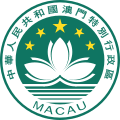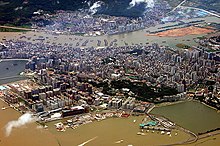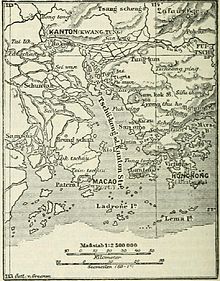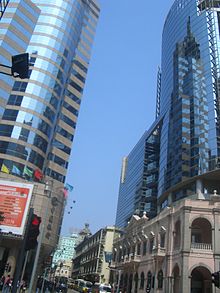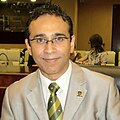Macau
|
中華人民共和國 澳門 特別 行政區 (Chinese) Região Administrativa Especial de Macau da República Popular da China (Portuguese) |
|||||
|
Jūng'wàh Yàhnmàhn Guhng'wòhgwok Oumún Dahkbiht Hàhngjingkēui (Cantonese) Zhōnghuá Rénmín Gònghéguó Àomén Tèbié Xíngzhèngqū (Mandarin) |
|||||
| Macau Special Administrative Region of the People's Republic of China | |||||
|
|||||
| Official language | Chinese ( Standard Chinese , Cantonese ), Portuguese | ||||
| Government system | Special Administrative Region | ||||
| Head of state | Xi Jinping | ||||
| Head of government |
Chefe do Executivo Ho Iat Seng |
||||
| surface | 30.3 km² | ||||
| population | 646,800 (estimate December 31, 2015) | ||||
| Population density | 20,997 inhabitants per km² | ||||
gross domestic product
|
2016 | ||||
| currency | Pataca | ||||
| National anthem |
|
||||
| Time zone | UTC +8 | ||||
| ISO 3166 | MO , MAC, 446 | ||||
| Internet TLD | .mo , .澳門 and .澳门 | ||||
| Telephone code | +853 | ||||
Macau ( Chinese 澳門 / 澳门 , Pinyin Àomén , Jyutping Ou 3 mun 4 * 2 , English Macao ; Portuguese Macau ) is a special administrative region of the People's Republic of China located about 50 kilometers west of Hong Kong . It was a Portuguese colony until 1999 . Macau is rich in colonial attractions. The main sources of income are legal gambling there and the associated tourism from Hong Kong and mainland China , which is why Macau is often referred to as the Monte Carlo of the East or Las Vegas of the East .
The full name of Macau is Cantonese Jūng'wàh Yàhnmàhn Guhng'wòhgwok Oumún Dahkbiht Hàhngjingkēui or in standard Chinese Zhōnghuá Rénmín Gònghéguó Aomen Tebie Xíngzhèngqū ( 中華人民共和國澳門特別行政區 / 中华人民共和国澳门特别行政区 ) and in the Portuguese language ( ).
The growth of the Chinese middle class and the resulting tourism have sparked a rapid economic boom in Macau. If counted as an independent state, Macau would be the fourth richest country in the world in terms of GDP per capita .
As measured by the Human Development Index, Macau is one of the most highly developed countries .
geography
landscape
Macau lies in the delta of the Pearl River . The area of today's special administrative zone originally consisted of three islands. The islands of Taipa and Coloane were connected to each other and Macau to the mainland by landfills . The islands are connected to the peninsula and the mainland by several bridges.
Both the peninsula and the island area consist of small granite hills surrounded by lowland areas. Before the hills were cleared for firewood and construction wood, the original vegetation consisted of evergreen tropical rainforest . The highest point is the Alto de Coloane on Coloane at 172.5 meters .
climate
| Macau | ||||||||||||||||||||||||||||||||||||||||||||||||
|---|---|---|---|---|---|---|---|---|---|---|---|---|---|---|---|---|---|---|---|---|---|---|---|---|---|---|---|---|---|---|---|---|---|---|---|---|---|---|---|---|---|---|---|---|---|---|---|---|
| Climate diagram | ||||||||||||||||||||||||||||||||||||||||||||||||
| ||||||||||||||||||||||||||||||||||||||||||||||||
|
Average monthly temperatures and rainfall for Macau
Source: wetterkontor.de. Retrieved February 27, 2014 .
|
|||||||||||||||||||||||||||||||||||||||||||||||||||||||||||||||||||||||||||||||||||||||||||||||||||||||||||||||||||||||||||||||||||||||||||||||||||||||||||||||||||||
Partly tropical influences give Macau a dry and humid monsoon climate . Four fifths of the average rainfall of 2,120 mm / m² falls in the rainy summer time (April to September) when the southwest monsoon blows. Temperatures range from 15 ° C in winter to an average of 29 ° C in summer. Aside from the rain, the summer months are hot, humid and uncomfortable. The winter months, on the other hand, are somewhat cooler, less humid and more bearable.
history
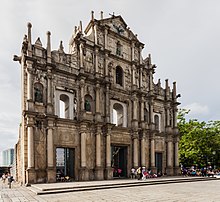
Macau's history is at least 6,000 years old. The place was originally settled by Chinese fishermen and farmers and leased to the Kingdom of Portugal in the mid-16th century . In the period that followed, the city developed into one of the most important trading centers for goods between Asia and Europe as part of the China trade . The trade in silk , spices and tea flourished and made Macau very prosperous.
From the middle of the 19th century, a dispute between China and Portugal over 150 years over the political and legal status of Macau began. In 1845 Portugal unilaterally declared Macau its free port . At the same time, Great Britain annexed the island of Hong Kong , only 62 kilometers from Macau , to which Macau lost its supremacy in Asian trade. In response to international pressure, the Chinese Empire had to recognize the permanent occupation and government of Macau by Portugal in 1887. From 1892 the reformer Sun Yat-sen stayed in the city, so that Macau became one of the most important starting points of the Chinese revolution .
Around this time, Macau developed into an appendage to the neighboring British colony in almost all economic areas. In contrast to Hong Kong, apart from a few temporary exceptions, the Chinese and Portuguese residents of the city lived in a symbiosis that was mutually beneficial. Negotiations about the return of the city to China, willing to compromise, took place between Portugal and the Republic of China as early as 1928 , but remained unsuccessful in the course of the Chinese Civil War and the Sino-Japanese War .
Due to the Portuguese policy of neutrality , Macau remained unoccupied by Japanese troops during World War II . During this time, the city took in many refugees of various nationalities. After the war, Portuguese President António de Oliveira Salazar unilaterally declared Macau an overseas province and an integral part of Portugal by decree , even though the Allies of the Republic of China had promised the return of all ports on the Chinese coast in 1943.
After the founding of the People's Republic of China in 1949, the new communist government in Beijing also demanded the return of Macau, but could not prevail because Portugal did not recognize mainland China's claim to sole representation . A solution to the “Macau Question” has been postponed indefinitely. On July 31, 1963, the United Nations Security Council rejected the construction of the Portuguese overseas provinces in UN Resolution 180 as contrary to international law.
In 1966 and 1974, Portugal submitted specific offers to the People's Republic of China to return Macau to China. The establishment of diplomatic relations between Portugal and the People's Republic of China would have been a prerequisite for such international treaties to be binding under international law , but this was rejected by the Portuguese government, which instead regarded the Republic of China in Taiwan as the sole government of all of China. It was not until 1979 that Portugal recognized the People's Republic of China on the basis of UN resolution 2758 of 1971 as the sole legitimate representative of the Chinese people.
This paved the way for a mutually acceptable return based on Deng Xiaoping 's reunification concept “ One country, two systems ”. Official bilateral talks began in 1985, a year after the British government agreed to return Hong Kong for 1997. Among other things, the vested rights and debt relationships as well as the existing investment protection, double taxation and mutual assistance agreements between Macau and Hong Kong had to be observed. After intensive negotiations, the two countries agreed in 1987 to return Macao to China for 1999.
On 19./20. December 1999 Macau was reunified with China at midnight. At the ceremony, then Chinese President Jiang Zemin said that "the return of Macau symbolized the definitive end of Western colonial rule over Asia." The official name of Macau has been Macau Special Administrative Region of the People's Republic of China since then . On the basis of the Sino-Portuguese Declaration of 1987 , Macau has high levels of autonomy and self-government until 2049 .
population
| year | population |
|---|---|
| 1950 | 196.483 |
| 1960 | 167,796 |
| 1970 | 246.195 |
| 1980 | 238.118 |
| 1990 | 343.935 |
| 2000 | 427.979 |
| 2010 | 536.969 |
| 2017 | 622,567 |
The entirety of the inhabitants of Macau are known as Macau , while Macanese represent a separate small ethnic group within the Macau. A large part of the population lives on the Macau peninsula or within the confines of the Concelho de Macau . Since the beginning of the 21st century in particular, the population has risen extremely sharply on the Macau Islands due to a lack of space . With around 21,000 inhabitants per square kilometer, Macau has a very high population density . Macau has the second highest life expectancy in the world. It is 84.5 years. Macau has a relatively old population, with less than a quarter under 25.
ethnicities
Of all 650,834 inhabitants of Macau at the 2016 census , 577,107 were Chinese , making this ethnic group the largest ethnic group with a resulting proportion of 88.7%. The second ethnic group traditionally represented in Macau are the Portuguese , who at 6,853 people or 1.1% make up only a small part. A total of 11,715 people have at least some of their Portuguese roots, which corresponds to a share of 1.8%; In detail, 3,889 people or 0.6% have a Sino-Portuguese ancestry and 973 people or 0.1% have a Portuguese and another non-Chinese ancestry. The Macanese , the original Creole population in Macau, are not included in the census, but can be found as a multi-ethnic community, especially among the Sino-Portuguese people or those who have Portuguese roots and ethnicities other than Chinese. In addition to the Chinese and Portuguese as well as Macanese, there are many predominantly Asian minorities in Macau, which together comprise a group of 59,998 people and thus 9.2% of the total population.
In recent decades, the ethnic composition of the population has changed significantly due to the high level of migration from abroad, including mainland China . The share of the Chinese in the total population decreased by 7 percentage points from 95.7% to 88.7% within 15 years from 2001 to 2016. A continuity can be observed: in 2011 it was 92.4% Chinese. The proportion of Chinese is decreasing, especially in favor of other Asian ethnic groups. While only 9,338 people or 2.1% of the population were neither Chinese nor Portuguese in 2001, their number rose to 32,413 or 5.9% by 2011; in 2016, a significantly higher figure was again achieved at 9.2%. About half of this 9.2% are likely to be Filipinos ; In addition, there are a quarter of Vietnamese and a quarter of people from other, but mainly Asian, ethnic groups.
For decades, a downward trend in the proportion of people with at least some of Portuguese descent could be observed. In 2001, 1.8% of the population had a Portuguese background, while their proportion fell to 1.6% in 2006 and 1.4% in 2011. In particular, the proportion of mixed Chinese-Portuguese people fell from 1.0% in 2001 to 0.8% in 2006 to 0.7% in 2011, while the proportion of people who were exclusively of Portuguese origin remained the same. This shows in particular the loss of importance of the mixed Macanese compared to the Portuguese, whereby the Sino-Portuguese culture of the Macanese is in danger, while only people of Portuguese origin from Portugal were able to maintain the proportion of Portuguese by the absolute number from 2001 to 2011 from 2,810 to 3,485 people. With the 2016 census, however, a change became apparent: While the mixed Sino-Portuguese population fell further to 0.6%, the exclusively Portuguese population doubled compared to 2011 from 3,485 people or 0.6% to 6,853 people or 1.1%. Overall, the proportion of those with at least partially Portuguese ancestors rose again to 1.8%.
Nationalities
The distribution of nationalities or citizenships roughly corresponds to the distribution of ethnic groups. Corresponding to the proportion of ethnic Chinese of 88.7% in 2016, 88.44% of the population or 575,585 people were Chinese citizens . The second largest nationality were the citizens of the Philippines with 30,080 people, which corresponds to a share of 4.62% of the total population. Only Portuguese citizens were held by 9,024 people or 1.39%. In addition, 4.73% had undisclosed Asian citizenship and 0.82% had undisclosed non-Asian citizenship.
Due to migration, a shift in the ratio of nationalities can be ascertained: In the penultimate census of 2011, 92.27% of the population still had Chinese citizenship with restricted rights in Macau, whereas in the last census in 2016 it was only 88.44%. On the other hand, the proportion of people with Filipino citizenship increased in particular, more than doubling within five years from 2.67% to 4.62%. The proportion of Portuguese nationals, similar to the proportion of ethnic Portuguese, rose from 0.91% to 1.39% between 2011 and 2016. The proportion of other Asian nationalities also rose sharply from 3.19% to 4.73%, while other non-Asian nationalities fell slightly from a proportion of 0.96% in 2011 to 0.82% in 2016.
The changes in the period from 2011 to 2016 were relatively large, while there were only minor changes from 2001 through 2006 to 2011. The proportion of holders of Chinese citizenship fell from 95.2% in 2001 to 93.9% in 2006 to 92.3% in 2011. At the 2001 census, Portuguese was the second most common nationality with a share of 2.0% Filipino owned only 1.2% of the total population. In the following years, however, Filipino citizenship replaced Portuguese citizenship in second place, with the proportion of people with Filipino nationality increasing to 2.0% and the proportion of people with Portuguese nationality falling to 1.7% in the five years up to 2006 . This trend continued until 2011, the proportion of Portuguese citizenship increased again from 2.0% by 0.7% to 2.7%, the proportion of people with Portuguese citizenship continued to decrease from 1, 7% down to 0.9%. Nevertheless, the period from 2001 to 2011 was significantly more constant than the shorter period from 2011 to 2016, in which the proportion of Filipino citizens increased much more clearly and the proportion of Portuguese citizens also recovered.
languages
Geographically, Macau belongs to the language area of Cantonese , a Chinese language that is spread throughout the Pearl River Delta and is also spoken in Hong Kong and Guangzhou (also known as Canton ). Due to the centuries-long Portuguese colonial period , Portuguese and the resulting Creole language Macanese are also historically anchored in Macau. The official languages are both Chinese and Portuguese. Bilingualism is strictly adhered to in official communications. For example, all legal texts , public documents and government websites are available in Chinese and Portuguese. Both Chinese and Portuguese are spoken in the Legislative Assembly , and speeches are made understandable by simultaneous interpreting for speakers of both official languages. In the past few years, the importance of English in Macau has increased due to its position as an international city, so that government websites are now also available in English. Although the Portuguese language should be seen as well secured by the described compliance with bilingualism, some critical voices say that the current Macau government is trying to limit the Portuguese-influenced influence, including the language.
religion
In 2006, it was estimated that around 80% Buddhists , 4% Roman Catholics and 1% Protestants lived in Macau . 15% belonged to another or no religion. Buddhism is also represented by non-Chinese organizations such as the Tibetan Buddhism of the Nyingmapa .
education
Macau has four universities and numerous other educational institutions:
- Macau Polytechnic Institute (Instituto Politécnico de Macau)
- University of Macau (Universidade de Macau)
- Macau University of Science and Technology
- Saint Joseph University (Universidade de São José)
- Institute for Tourism Studies
- Kiang Wu Nursing College
- Macau Millennium College
- Macau Security Forces Training College
- Macau Institute of Management
- United Nations University International Institute for Software Technology
- Institute of European Studies of Macau
politics
Political system
At the head of the government is the Chefe do Executivo de Macau . Legislation is made by the Macau Legislative Assembly .
Administrative division
Under Portuguese administration, the area was divided into two cities until 1999:
- Concelho de Macau (澳門 市 )
- Concelho das Ilhas (海島 市 )
The concelho de Macau itself was divided into five parishes:
- Freguesia de Nossa Senhora de Fátima (花 地 瑪 堂 區 )
- Freguesia de Santo António ( 聖安多尼 堂 區 )
- Freguesia de São Lazaro ( 望 德 堂 區 )
- Freguesia de São Lourenço ( 風 順 堂 區 or 聖 老 愣 佐 堂 區 )
- Freguesia da Sé (大堂 區 )
The concelho das Ilhas was divided into two parishes:
- Freguesia da Nossa Senhora do Carmo ( 嘉 模 堂 區 ) on Taipa Island
- Freguesia do São Francisco Xavier ( 聖 方 濟 各 堂 區 ) on Coloane Island
The new land area Cotai , located between the islands of Taipa and Coloane, was not assigned to any municipality.
The independent administrations of the cities and municipal districts were dissolved on December 31, 2001. It was replaced by the Instituto para os Assuntos Cívicos e Municipais (Administration of Civic and Urban Affairs).
Town twinning
Macau currently has the following city partnerships :
-
 Lisbon , Portugal , since 1982
Lisbon , Portugal , since 1982 -
 Brussels , Belgium , since 1991 (friendship agreement)
Brussels , Belgium , since 1991 (friendship agreement) -
 Porto , Portugal , since 1997
Porto , Portugal , since 1997 -
 Linköping , Sweden , since 1997
Linköping , Sweden , since 1997 -
 Coimbra , Portugal , since 1998
Coimbra , Portugal , since 1998 -
 São Paulo , Brazil , since 2000
São Paulo , Brazil , since 2000 -
 Da Nang , Vietnam , since 2006 (cooperation agreement)
Da Nang , Vietnam , since 2006 (cooperation agreement) -
 Praia , Cape Verde , since 2007
Praia , Cape Verde , since 2007
Culture
Attractions
- Façade ruins of the Pauluskirche (Ruinas de São Paulo)
- Macau Tower (338 meters)
- Casino Lisboa and Grand Lisboa
- Grand Prix Museum
- Penha Church
The UNESCO took the historic old town in 2005, the World Heritage Site because of the role of the city as a place of contact between China and the West on what is reflects in the architecture.
Regular events
Highlights of the city's annual calendar of events include the Chinese New Year Celebrations, the Macau Arts Festival, the Tun Ng Dragon Boat Festival, the International Fireworks Display Contest and the International Music Festival.
Since 1954, every year in November at the street circuit Guia Circuit of Macau Grand Prix held, the various race for motorcycles , touring cars and single-seaters there.
Economy and Infrastructure
The manufacture of fireworks and textiles is economically important for Macau . The unemployment rate is given as 2% in 2017 and is therefore very low.
Gambling

The gamble has long formed a key source of income of Macao. In 1962, the Sociedade de Turismo e Diversões de Macau (STDM, German: Macau Reise- und Unterhaltungsgesellschaft) was founded, a company organized under private law, which at times held the monopoly on gambling and maintained other activities in the leisure and tourism industry . The majority of the STDM was owned by Stanley Ho (30 percent) and Teddy Yip (27 percent). The casinos made Macau attractive to regional tourists. Until the liberalization of the market in 2002, the STDM generated up to 60 percent of Macau's gross domestic product in a few years.
In 2011 there were 34 casinos with $ 33.9 billion in revenue. Compared to 2010, sales have increased by 42 percent. Gambling has more than tripled the number of tourists visiting Macau from eight million in 2000 to 29,324,822 in 2013. Macau casinos had six times the revenue of Las Vegas in 2013. In January 2014, 2,503,609 tourists came. This is reflected above all in the construction industry, because in view of the small area of Macau, high-rise buildings are mainly built.
Since the fall of the gambling monopoly at the end of 2002, mainly US consortia from Las Vegas , Nevada have applied for a license to build casinos. The investors want to recreate the Las Vegas Strip on the artificial embankment between the two southern islands Taipa and Coloane . In May 2004, the golden facade of Sands Macau opened, a casino (with a hotel since 2007), the cost of which was amortized in less than a year. A large casino, hotel and leisure complex has emerged near the southern flank of Taipa. Currently the largest in the world. The centerpiece is the casino hall, which is easily accessible from all sides and has an exceptionally large area of 51,000 square meters.
Texas Hold'em Poker has been officially allowed as a game of chance in Macau since January 2008 . In May 2011, the Galaxy Resort was opened in Macau , another player's palace with 2,200 hotel rooms, 50 restaurants, an artificial beach and a wave pool .
Since 1989 there has been a racecourse in Macau with a capacity of 15,000 seats, where betting on the outcome of the races is legal. In 2012, the minimum age for gambling in Macau was increased from 18 to 21 years.
- The Venetian Macau
The Resort-Hotel-Casino The Venetian Macao was built between 2004 and 2007 and (as of March 2013) is the sixth largest building in the world in terms of usable space. The Venetian is dominated by the 151 meter high angled hotel block with 39 floors and 3000 suites. They are subsidized like in Las Vegas to attract the required masses of gamblers to the casino. In addition to the hotel operations and guarantee of occupancy, a 111,000 square meter conference center , a fully equipped theater and an event arena with 15,000 seats were built. The restaurants and shops distributed throughout the complex occupy an area of 149,000 square meters. In the first five months after opening on August 29, 2007, 10 million guests were counted. The staff costs in the complex are calculated at around 25,000 employees, that is one in five jobs in Macau.
The Venetian, like its two-thirds smaller model in Las Vegas, is framed by a replica of Venetian canals with gondolas on street fronts under an artificial sky in permanent twilight. The decor is in the Venetian style; However, the Chinese lucky charms dragon and fish are integrated into the equipment everywhere near the casino . Outside there is the solitary campanile from St. Mark's Square , which was recreated in original size including the tower figure (98.6 meters). A large pond lights up in the facility when it is dark.
traffic

The Macau Peninsula and Taipa Island are connected by three bridges. The newest bridge, the Sai Van Bridge ( 西 灣 大橋 / 西 湾 大桥 , Xīwān Dàqiáo , Jyutping Sai 1 waan 1 Daai 6 kiu 4 ) has been in operation since early 2005 ; Open to traffic in western Macau. Only through this new and higher bridge can the island of Taipa be reached by car even if there is a typhoon warning. The two older bridges (Governor Nobre de Carvalho Bridge and Ponte da Amizade; since 1994; in the east) are not adequately protected from wind and waves.
There are regular high-speed ferries between the ports of Macau and Taipa. The Macau – Hong Kong route is operated around 150 times a day by hydrofoils . There are connections to Hong Kong International Airport , the China Ferry Pier in Kowloon and the Macau Ferry Terminal on Hong Kong Island. The crossing takes about an hour. There are also ferry connections to Shekou ( 蛇口 , Shékǒu , Jyutping Se 4 hau 2 ) ( Shenzhen ) and to Shenzhen Airport as well as bus routes to Gongbei ( 拱北 , Gǒngběi , Jyutping Gung 2 bak 1 ) ( Zhuhai ) and Guangzhou . There are also regular helicopters to Hong Kong and Shenzhen.
Macau has had its own international airport, Macau International Airport, since 1995 . Inner-city traffic and even local traffic on the surrounding islands are relieved by an effective bus system. All vehicles are equipped with air conditioning. In contrast to mainland China , like in Hong Kong, there is left-hand traffic in the Macau area .
Plans are currently underway for a rail-based local transport system, the Macau Light Rail Transit, which will consist of three lines (circular line, north-south line for connection to the islands and a line to the airport) and a total length of 27 km. The new third bridge between Macau and Taipa, which went into operation in 2005, is already designed for the rail link. Construction was originally supposed to start in 2006, but this has now been delayed until 2012.
Personalities
sons and daughters of the town
- Victor Hugo de Azevedo Coutinho (1871–1955), naval officer, professor at the University of Coimbra and politician, Prime Minister 1914–1915
- João Tamagnini de Sousa Barbosa (1883–1948), military and politician, Prime Minister 1918–1919
- Geoffrey de Ste Croix (1910-2000), British historian
- José Lai Hung-seng (* 1946), bishop
- Eurico de Jesus (* 1977), racing car driver
Honorary citizen
- Hermann-Josef Weidinger OPraem (1918-2004), Austrian Premonstratensian canon, known as a herb pastor ; Honorary Citizen of Macau
See also
literature
- Peter Haberzettl and Roderich Ptak: Macau. Geography, history, economy and culture . Harrassowitz, Wiesbaden 1995, ISBN 3-447-03673-7 .
- Luís Filipe Barreto: Macau Scientific and Cultural Center. Museum guide. Centro Científico e Cultural de Macau, Lisbon 1999, ISBN 972-8586-01-9 .
Web links
- Official Macau website (English, Chinese, Portuguese)
- Country information from the Federal Foreign Office on Macau
- Database of indexed literature on the social, political and economic situation in Macau
- CIA World Factbook: Macau (English)
- Macau country statistics from factfish
- Entry on the UNESCO World Heritage Center website ( English and French ).
- University of Macau (English, Chinese, Portuguese)
Individual evidence
- ^ The World Factbook. CIA , accessed February 27, 2014 .
- ^ Total area 2014. Macau Cartography and Cadastre Bureau, accessed March 16, 2015.
- ^ Government of Macao Special Administrative Region Statistics and Census Service: Population estimate (select 2015), accessed August 16, 2016.
- ↑ imf.org.
- ↑ Macau is the largest game library on the planet. In: Welt Online . Retrieved June 11, 2017 .
- ↑ Human Development Report 2019 (English; PDF: 1.7 MB, 40 pages ) on hdr.undp.org
- ↑ a b Macau: Land. In: Encyclopædia Britannica . Retrieved August 8, 2017 .
- ^ Wei Qiao, Karl-Heinz Pohl, Dorothea Wippermann: Bridge between cultures. LIT Verlag, 2003, p. 74.
- ↑ Thomas Beck: Überseegeschichte. Franz Steiner Verlag, 1999, p. 276.
- ^ Peter Haberzettl, Roderich Ptak: Macau. Geography, history, economy and culture. Otto Harrassowitz Verlag, 1995, p. 19 f.
- ↑ Source: UN: World Population Prospects - Population Division - United Nations. Retrieved July 29, 2018 .
- ^ Macau: Parishes & Cities - Population Statistics, Maps, Charts, Weather, and Web Information. Retrieved April 10, 2019 .
- ^ Wei Qiao, Karl-Heinz Pohl, Dorothea Wippermann: Bridge between cultures . LIT Verlag, 2003, p. 74 .
- ↑ a b Macau: People. In: Encyclopædia Britannica . Retrieved August 8, 2017 .
- ↑ See section Nationalities .
- ↑ a b 2016 population by-census detailed results. DSEC, May 2017, accessed April 10, 2019 .
- ↑ a b Resultados globais dos intercensos 2011. DSEC, May 2012, accessed on April 10, 2019 (Chinese, Portuguese, English).
- ↑ a b Resultados globais dos intercensos 2006. DSEC, May 2006, accessed on April 10, 2019 (Chinese, Portuguese, English).
- ↑ Tens of thousands more are entitled to Portuguese papers through an entry in the Portuguese central register. However, since China does not recognize any form of dual statehood, this is not recorded statistically (details in the respective linked citizenship articles).
- ↑ Macanese. Accessed April 10, 2019 .
- ↑ Fact Sheet. In: gcs.gov.mo. Retrieved April 10, 2019 .
- ↑ 高 天賜: Jose Pereira Coutinho. In: YouTube . December 19, 2018, accessed April 10, 2019 .
- ^ Macau SAR Government Portal. Retrieved April 10, 2019 (American English).
- ↑ In Macau, Portuguese elites feel squeezed out by Chinese influence . In: Reuters . October 5, 2018 ( reuters.com [accessed April 10, 2019]).
- ^ Sister Cities of Macao. Website of the Instituto para os Assuntos Civicos e Municipais, accessed on February 21, 2016 (English).
- ↑ Historic Center of Macau. UNESCO World Heritage Center, accessed August 19, 2017 .
- ↑ Macau celebrates festivals. Travel EXCLUSIV magazine website, accessed January 5, 2015.
- ^ The World Factbook - Central Intelligence Agency. In: cia.gov. Accessed August 6, 2018 .
- ^ A b Newman MK Lam, Ian Scott: Gaming, Governance and Public Policy in Macao. Hong Kong University Press, ISBN 978-988-8083-28-2 , p. 23.
- ^ Richard W. Butler, Roslyn Russell: Giants of Tourism. CABI 2010, ISBN 978-1-84593-653-2 , p. 175.
- ^ Andreas Lorenz: Tourist boom city Macau: They just want to play. In: Spiegel Online . March 7, 2012, accessed February 27, 2014 .
- ↑ Visitor Arrivals for December 2013. In: dsec.gov.mo. Government of Macao Special Administrative Region Statistics and Census Service, accessed February 27, 2014 .
- ↑ Nina Trentmann: Macau degrades Las Vegas to a provincial casino. In: welt.de, May 9, 2014, accessed on May 9, 2014.
- ↑ Visitor Arrivals for January 2014. In: dsec.gov.mo. Government of Macao Special Administrative Region Statistics and Census Service, accessed February 27, 2014 .
- ↑ Galaxy Resort: Macau opens billion dollar players' palace. In: Spiegel Online. May 16, 2011, accessed February 27, 2014 .
- ^ Venetian Macau Hotel Tower. Building data on Skyscraper Center, accessed October 7, 2015.
Coordinates: 22 ° 12 ' N , 113 ° 33' E

